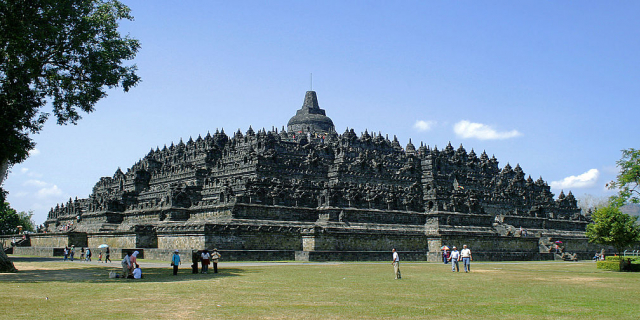The Sari Temple (Indonesian: Candi Sari; Javanese: ꦕꦤ꧀ꦝꦶꦱꦫꦶ, romanized: Candhi Sari, also known as Candi Bendan) is an 8th-century Buddhist temple: 90 located at Dusun Bendan, Tirtomartani village, Kalasan, Sleman Regency, Special Region of Yogyakarta, Indonesia. It is located about 130 meters (430 ft) northeast of the Kalasan temple. The temple was a two-story building with wooden beams, floors, and stairs completed with windows and doors; all from organic materials which now are decayed and gone. It is suggested that the original function of this building was a vihara (Buddhist monastery), a dwelling place for monks. The temple's name Sari or Saré translates as "to sleep" in Javanese, which also confirms the habitation nature of the buildin...Read more
The Sari Temple (Indonesian: Candi Sari; Javanese: ꦕꦤ꧀ꦝꦶꦱꦫꦶ, romanized: Candhi Sari, also known as Candi Bendan) is an 8th-century Buddhist temple: 90 located at Dusun Bendan, Tirtomartani village, Kalasan, Sleman Regency, Special Region of Yogyakarta, Indonesia. It is located about 130 meters (430 ft) northeast of the Kalasan temple. The temple was a two-story building with wooden beams, floors, and stairs completed with windows and doors; all from organic materials which now are decayed and gone. It is suggested that the original function of this building was a vihara (Buddhist monastery), a dwelling place for monks. The temple's name Sari or Saré translates as "to sleep" in Javanese, which also confirms the habitation nature of the building.
Historians suggested that the temple was built around the same time as the Kalasan temple. The Kalasan inscription dated 778 AD, in Pranagari script written in Sanskrit, mentions that the temple was erected by the will of Guru Sang Raja Sailendravamçatilaka (the Jewel of the Shailendra dynasty) who succeeded in persuading Maharaja Tejapurnapana Panangkaran (in other parts of the inscription also called as Kariyana Panangkaran) to construct a holy building for the boddhisattva Tara and also build a vihara (monastery) for Buddhist monks from Sailendra family's realm. Panangkaran awarded the Kalara village to the Sangha (the Buddhist monastic community).[1] Based on this inscription, Candi Sari was probably the monastery for monks who served the nearby Kalasan temple.
The ruins were discovered in the early 1920s, and in 1929, an effort to reconstruct the temple began and was finished in 1930. However, it was incomplete because many parts are missing including the outer base that surrounds the temple, and the extended front room and front stairs that once projected from the east wall of the temple.[2]































Add new comment